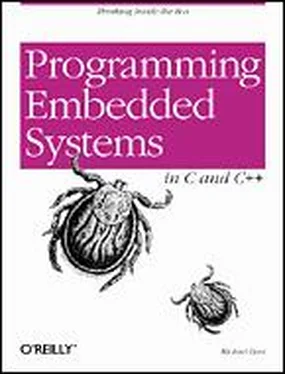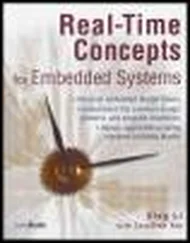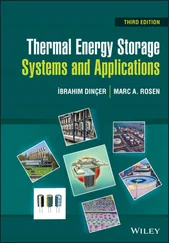A number of commercial C++ compilers already support the Embedded C++ standard specifically. Several others allow you to manually disable individual language features, thus enabling you to emulate Embedded C++ or create your very own flavor of the C++ language.
Of course, not everything introduced in C++ is expensive. Many older C++ compilers incorporate a technology called c-front that turns C++ programs into C and feeds the result into a standard C compiler. The mere fact that this is possible should suggest that the syntactical differences between the languages have little or no runtime cost associated with them. [27] Moreover, it should be clear that there is no penalty for compiling an ordinary C program with a C++ compiler.
It is only the newest C++ features, like templates, that cannot be handled in this manner.
For example, the definition of a class is completely benign. The list of public and private member data and functions are not much different than a struct and a list of function prototypes. However, the C++ compiler is able to use the public and private keywords to determine which method calls and data accesses are allowed and disallowed. Because this determination is made at compile time, there is no penalty paid at runtime. The addition of classes alone does not affect either the code size or efficiency of your programs.
Default parameter values are also penalty-free. The compiler simply inserts code to pass the default value whenever the function is called without an argument in that position. Similarly, function name overloading is a compile-time modification. Functions with the same names but different parameters are each assigned unique names during the compilation process. The compiler alters the function name each time it appears in your program, and the linker matches them up appropriately. I haven't used this feature of C++ in any of my examples, but I could have done so without affecting performance.
Operator overloading is another feature I could have used but didn't. Whenever the compiler sees such an operator, it simply replaces it with the appropriate function call. So in the code listing that follows, the last two lines are equivalent and the performance penalty is easily understood:
Complex a, b, c;
c = operator+(a, b); // The traditional way: Function Call
c = a + b; // The C++ way: Operator Overloading
Constructors and destructors also have a slight penalty associated with them. These special methods are guaranteed to be called each time an object of the type is created or goes out of scope, respectively. However, this small amount of overhead is a reasonable price to pay for fewer bugs. Constructors eliminate an entire class of C programming errors having to do with uninitialized data structures. This feature has also proved useful for hiding the awkward initialization sequences that are associated with complex classes like Timer and Task .
Virtual functions also have a reasonable cost/benefit ratio. Without going into too much detail about what virtual functions are, let's just say that polymorphism would be impossible without them. And without polymorphism, C++ would not be a true object-oriented language. The only significant cost of virtual functions is one additional memory lookup before a virtual function can be called. Ordinary function and method calls are not affected.
The features of C++ that are too expensive for my taste are templates, exceptions, and runtime type identification. All three of these negatively impact code size, and exceptions and runtime type identification also increase execution time. Before deciding whether to use these features, you might want to do some experiments to see how they will affect the size and speed of your own application.
Appendix A. Arcom's Target188EB
All of the examples in this book have been written for and tested on an embedded platform called the Target188EB. This board is a low-cost, high-speed embedded controller designed, manufactured, and sold by Arcom Control Systems. The following paragraphs contain information about the hardware, required and included software development tools, and instructions for ordering a board for yourself.
The Target188EB hardware consists of the following:
• Processor: Intel 80188EB (25 MHz)
• RAM: 128K of SRAM (256K available), with optional battery backup
• ROM: 128K of EPROM and 128K of Flash (512K maximum)
• Two RS232-compatible serial ports (with external DB9 connectors)
• 24-channel parallel port
• 3 programmable timer/counters
• 4 available interrupt inputs
• An 8-bit PC/104 expansion bus interface
• An optional 8-bit STEBus expansion interface
• A remote debugging adapter containing two additional RS232-compatible serial ports
Software development for this board is as easy as PC programming. Free development tools and utilities included with the board allow you to develop your embedded application in C/C++ or assembly language, using Borland's C++ compiler and Turbo Assembler. In addition, a debug monitor preinstalled in the onboard Flash memory makes it possible to use Borland's Turbo Debugger to easily find and fix bugs in your application. Finally, a library of hardware interface routines makes manipulating the onboard hardware as simple as interacting with C's stdio library.
All of the programs in this book were assembled, compiled, linked, and debugged with a copy of Borland C++ 3.1. However, any version of the Borland tool chain capable of producing code for an 80186 processor will do just fine. This includes the popular versions 3.1, 4.5, and 4.52. If you already have one of these versions, you can use that. Otherwise, you might want to check with Arcom to find out if the latest version of Borland's tools is compatible with their development and debugging tools.
In small quantities, the Target188EB board (part number TARGET188EB-SBC) retails for $195. [28] The price and availability of this board are beyond my control. Please contact Arcom for the latest information.
Ordinarily, this does not include the software development tools and power supply. However, Arcom has generously agreed to provide a free copy of their Target Development Kit (a $100 value) to readers of this book. [29] No financial or contractual relationship exists between myself or O'Reilly & Associates, Inc. and Arcom Control Systems. I only promote the board here out of thanks to Arcom for producing a quality product and supporting me with this project.
Simply mention the book when placing your order and you will be eligible for this special offer. To place an order, contact the manufacturer directly at:
Arcom Control Systems
13510 South Oak Street
Kansas City, MO 64145
Phone: 888-941-2224
Fax: 816-941-7807
Email: sales@arcomcontrols.com
Web: http://www.arcomcontrols.com/
ASIC
Application-Specific Integrated Circuit. A piece of custom-designed hardware in a chip.
address bus
A set of electrical lines connected to the processor and all of the peripherals with which it communicates. The address bus is used by the processor to select a specific memory location or register within a particular peripheral. If the address bus contains n electrical lines, the processor can uniquely address up to 2 n such locations.
application software
Software modules specific to a particular embedded project. The application software is unlikely to be reusable across embedded platforms, simply because each embedded system has a different application.
Читать дальше












